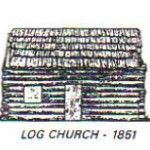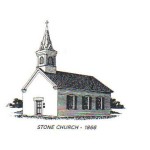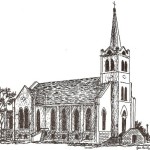The Log Cabin Church
 This is a picture of a small scale reproduction of the original log cabin church which was built in 1850. A wood floor was laid in 1856 and the building was sold at auction in 1869. This reproduction was made by Mr. William Zorn and it is on display in the Stone Church museum.
This is a picture of a small scale reproduction of the original log cabin church which was built in 1850. A wood floor was laid in 1856 and the building was sold at auction in 1869. This reproduction was made by Mr. William Zorn and it is on display in the Stone Church museum.
The first settlers arrived in our area from Germany in May, 1846. Among them were the two men who are considered to be the founders of Meyersville, Mr. Friedrich Hausmann and Mr. Adolph Meyer, after whom Meyersville was named. They were soon followed by other groups and the story is told, that, as one of these groups was sailing across the restless Atlantic, a storm arose, and the angry wind and waves threatened the lives of the voyagers. They cried to the Lord for help, and they vowed that, if He would grant them a safe landing at their destination, they would build a house of worship to His Honor. Their prayers were answered, and these Christians kept their promise as soon as circumstances permitted.
They worked hard, together clearing the land by hand with primitive tools, wooden spade, grubbing hoe, ax, and wooden plow, in order to build their homes and prepare their fields. A Methodist pastor, named Bauer, visited the little band of Christians here and spoke words of comfort and hope. Later another Methodist pastor, named Grote, came to preach and minister to the settlers and encouraged them to build a house of worship. Mr. and Mrs. Christopher Thieme donated an acre of land upon which the little log church was built in 1850. They later sold 5 more acres of land to the congregation for $1.00 per acre.
Pastor Grote wanted to organize these Christians to form a Methodist congregation but they were staunch and faithful Lutherans. They remained true to the Lutheran doctrines and convictions and refused to surrender to any other. In 1851 a young Lutheran pastor, Christoph Adam Sager, was persuaded to come to this new community and a Lutheran congregation was organized.
A parsonage was built on the church property, also a log cabin. Several logs from this first parsonage are on display in our museum in the Stone Church. A cemetery was laid out and a rail fence was built around it. Before long there were many graves in the little cemetery, most of them infants and small children for life was very primitive and difficult for the early settlers.
The Stone Church
 In May, 1866, the congregation passed a resolution to build a House of Worship as a thankoffering for the peace following the end of the Civil War. This is the way the original Stone Church looked when it was dedicated in 1867. The original Stone Church was 46 feet long and 28 feet wide. The walls are 2 feet thick and were 14 feet high.
In May, 1866, the congregation passed a resolution to build a House of Worship as a thankoffering for the peace following the end of the Civil War. This is the way the original Stone Church looked when it was dedicated in 1867. The original Stone Church was 46 feet long and 28 feet wide. The walls are 2 feet thick and were 14 feet high.
The bell for the new church was ordered from overseas and had arrived some time before the building was finished. It was kept in Mr. Friedrich Hausmann’s store and if anyone wanted to hear the tone of the bell, for a dime, Mr. Hausmann would ring it. These dimes helped pay for the bell, which is the same bell that hangs in the steeple of our present church today and calls us to worship every Sunday morning.
In 1896, the Old Stone Church was renovated and rededicated. The ceiling was raised 6 feet and a new steeple was built 16 feet higher and adorned with a cross and emblems said to have been made by Pastor Westerhoff. Eight columns or pillars were added to support the new steeple. Stained wood, artistically arranged and rectangular embossed leather insets provided the ceiling and inside belltower with much beauty. The Ladies Aid which was organized in 1895 purchased the altar, pulpit, and pews.
In 1919 a resolution was adopted to build a new church and it was decided that the Old Stone Church should remain standing. The new church was dedicated in 1921 and for the next 30 years the Old Stone Church fell into disuse, was neglected, and was used for a storage building. In July of 1951 the congregation voted to dismantle the Old Stone Church if and when that became necessary.
Fortunately many members were opposed to dismantling the Old Stone Church and when lightning struck its steeple in the Spring of 1957, doing considerable damage to the steeple and roof, it was evident that it was time to either dismantle or repair the building. After much debate and consideration, on January 12, 1958, the congregation rescinded the motion of July 1951 and voted to restore the Old Stone Church.
The restored church was rededicated in a Homecoming and Historic Celebration on October 26, 1958.
In 1962, the congregation was awarded a Texas Historic Building Medallion by the Texas State Historical Survey Committee. This medallion has been afixed to the front of the Stone Church.
In 1963, the Stone Church’s pulpit was returned after having been used for several years by a Latin American congregation in Alice, Texas. It was reinstalled it in its original place, behind the altar and new steps were built, like the original ones, leading up to the pulpit from both sides. We also placed show cases in the Church with pictures, documents, Bibles, vessels, and other artifacts which had been used in this Church and in the Log Cabin Church of 1850.
The Old Stone Church is open to visitors every day of the year and is still used for special events such as weddings, Advent Services, and Easter Sunrise Services.
The Brick Church
 This picture shows our present church which was built in the Gothic style. The cornerstone was laid on May 13, 1920 and the church was dedicated on July 20, 1921.
This picture shows our present church which was built in the Gothic style. The cornerstone was laid on May 13, 1920 and the church was dedicated on July 20, 1921.
This church is 90 feet long and 40 feet wide with a transept 10 x 20 and a chancel 18 by 20 feet. Its steeple is 100 feet high and the basement is 40 by 50 feet. The cost of the building was approximately $24,000.
In 1929 a Delco Electric Light Plant was purchased for $855.85 and installed in the church. In 1939 Rural Electricity was installed and in 1940 hydro gas (butane) was installed for heating the church. In 1959, the gas heaters were replaced by thermostatically controlled electric wall heaters.
In 1948 our present pipe organ was built and chimes were later added. The organ was renovated in 1988.
In 1958 a building was purchased from the Meyersville Independent School District and moved next to the church to serve as our Parish Hall. It has since been renovated and expanded. On September 15, 1991 an Anniversary and Rededication Celebration was held at the Parish Hall to celebrate our Church History Years from 1846 to 1991.
The Pastors of St. John
The following pastors have served St. John:
- 1850-1854 — Christoph Adam Sager
- 1855-1855 — Johannes Haerdtle (only a few months)
- 1855-1855 — Eduard Mueller (about 7 months)
- 1856-1867 — Johannes Schaeg
- 1868-1870 — Friedrich Holzinger (assisted by Heinrich Pfenninger for a short time)
- 1871-1878 — Michael Oehler
- 1879-1893 — Gottlob Stricker
- 1893-1904 — Wilhelm Westerhoff
- 1904-1916 — Friedrich Gerstmann
- 1916-1922 — P. Gogolin
- 1922-1930 — H. C. Poehlmann
- 1930-1933 — H. C. Wehmeyer
- 1933-1939 — Max Heinrich
- 1939-1967 — E. A. Arhelger
- 1967-1975 — Milroy Gregor
- 1975-1985 — William Hassel
- 1986-1989 — William Laubenberg
- 1990-2004 — Nicholas Wagner
- 2005-2011 — Eric L. Petty
- 2011-Present — John Boor
Several of our past pastors are buried in St. John’s cemetery. They include Pastor Mueller who died of yellow fever, Pastor Schaeg, Pastor Holzinger, and Pastor Wagner.
Prior to forming as a Lutheran congregation, the people of Meyersville were ministered by Methodist pastors Bauer and Grote. It was under Pastor Grote’s encouragement that the original Log Cabin Church was built. Pastor Grote tried to organize a Methodist congregation here but when the settlers learned that they would have to deed over the church and land to the Methodist Church, at large, they were determined to remain true to their Lutheran backgrounds and search for a Lutheran pastor to lead them.
Pastor Schaeg actually left the congregation for a period of about 5 months in 1857 when Saloma Fehr tried to take over the leadership of the congregation. Pastor Schaeg was persuaded to return to the congregation after Saloma Fehr was removed from the Synod.
In 1997, we welcomed Elizabeth Hanley as the first intern to serve at St. John.
150 Years of History Celebrated
The previous information and much more, including baptismal, confirmation, marriage, and burial records can be found in the Sesquicentennial Book of St. John Evangelical Lutheran Church which was published in 2001. Copies of this book are available for purchase at the church office for $15. The book also includes a timeline of important events in the church, a pictorial & biographical listing of pastors who have served the congregation, and a history of the Meyersville community, as well as numerous photos, maps, and drawings of significance to the church and community.

7 Responses to History